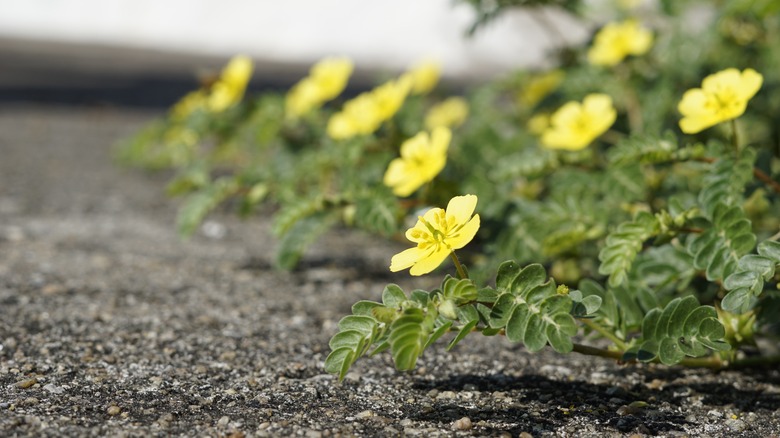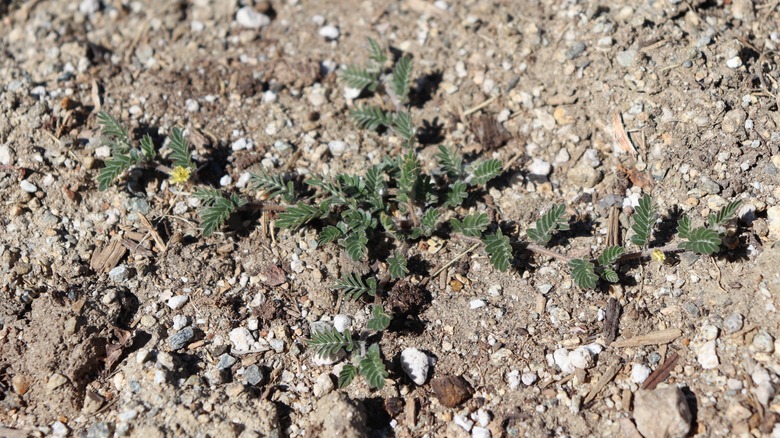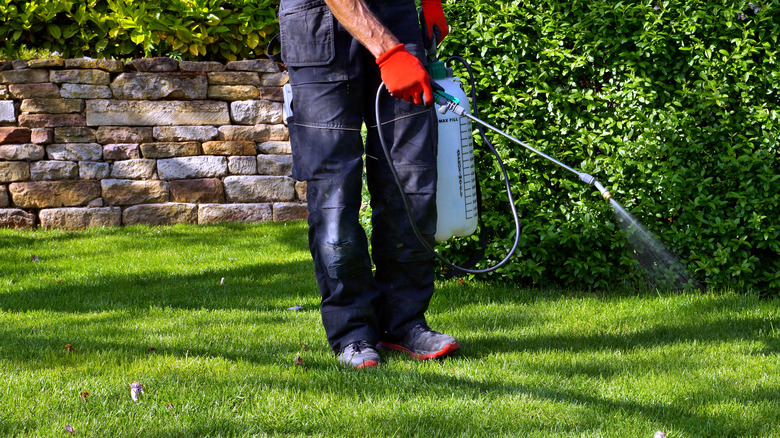How To Get Puncturevine Out Of Your Lawn
Keeping your yard free of invasive plants is a challenge, often requiring applications of fertilizer and herbicides at the right time of the year to treat weeds in the lawn. However, there are certain plants that you should not wait to try to eliminate — take care of them as soon as you see them. Puncturevine is a challenging weed to control because of its sharp burs, but you can get rid of it with a mixture of hoeing, pulling, and targeted herbicide application.
Recognizing puncturevine is a bit of a challenge when the plant is young, but you're sure to notice it as it matures. When it begins growing, the puncturevine will extend its branches from a central root system flat across the ground, like a vine. It eventually can spread up to six feet outward from the central root. As puncturevine grows, its oval-shaped leaves may reach up to ⅕ inch in length. They usually grow in pairs on either side of the stem. You may see clusters of between three and seven pairs of leaves.
Puncturevine's flowers are a distinguishing characteristic, too. They are bright yellow with five petals, each of which is about ¼ inch in length. When the flowers appear, the puncturevine begins to produce its "fruit," which is a woody bur that has five lobes, called a goathead sticker. It is sharp enough to pierce bicycle tires and embed itself in your foot.
Best way to remove puncturevine weeds by hand
Puncturevine is one of the most common garden weeds. Because of its spiky burs, you will want to remove it as quickly as possible before it can spread into your yard and cause problems for your kids and pets. You may decide you want to try to control this noxious weed through hands-on work because you don't want to risk using harsh chemicals around your garden plants or in the lawn near grass plants. If the puncturevine is already mature, you should wear thick work gloves to protect your hands from the spiky burs. You then can pull these weeds by hand. Follow the branches back to the main root. If the ground is moist, you should be able to remove the entire taproot, meaning the plant will not grow back this season.
You also can use a hoe or a shovel to try to dig up the puncturevine. You may risk spreading the fruit across the ground as you chop out the weed and jostle the seeds, so use caution during this process. Ideally, you will use the hoe or shovel in the spring before the fruit appears on the mature plant. If not, make sure that you search for and discard all of the spiny burs that fall off after using the hoe. You should not place the puncturevine and its burs into your compost pile, as the seeds will survive composting. Discard all parts of this plant.
Controlling puncturevine weeds through herbicide application
Because puncturevine is an annual broadleaf plant, you may want to make use of pre-emergent herbicides to try to control it before it appears. As an annual, you know that the plant will try to regrow every year, making the pre-emergent an effective option. Such pre-emergent products are a smart choice in turfgrass areas where you don't want a harsh herbicide spray to affect the health of the grass. Look for pre-emergents that have oryzalin, benefit, or trifluralin in the formula to have the best results. Because puncturevine is a broadleaf weed, you may be able to use a weed and feed granular product to try to control the unwanted plants after they sprout in your lawn. You'll often apply the weed and feed during the spring when the puncturevine is starting to appear.
If you prefer to spray the puncturevine weeds with a herbicide after these weeds sprout, you can use products with 2,4-D, glyphosate, or dicamba. It's especially dangerous to use glyphosate around the grass in your lawn, though, because it will kill every plant it touches. Never make use of a herbicide without reading the product label first to understand exactly how it may affect the nearby plants that you want to keep. You also should follow the exact directions for application. Remember, such applications only work when the plant has already sprouted, but you'll have better luck controlling the puncturevine if you spray the herbicide while the plant is young.


